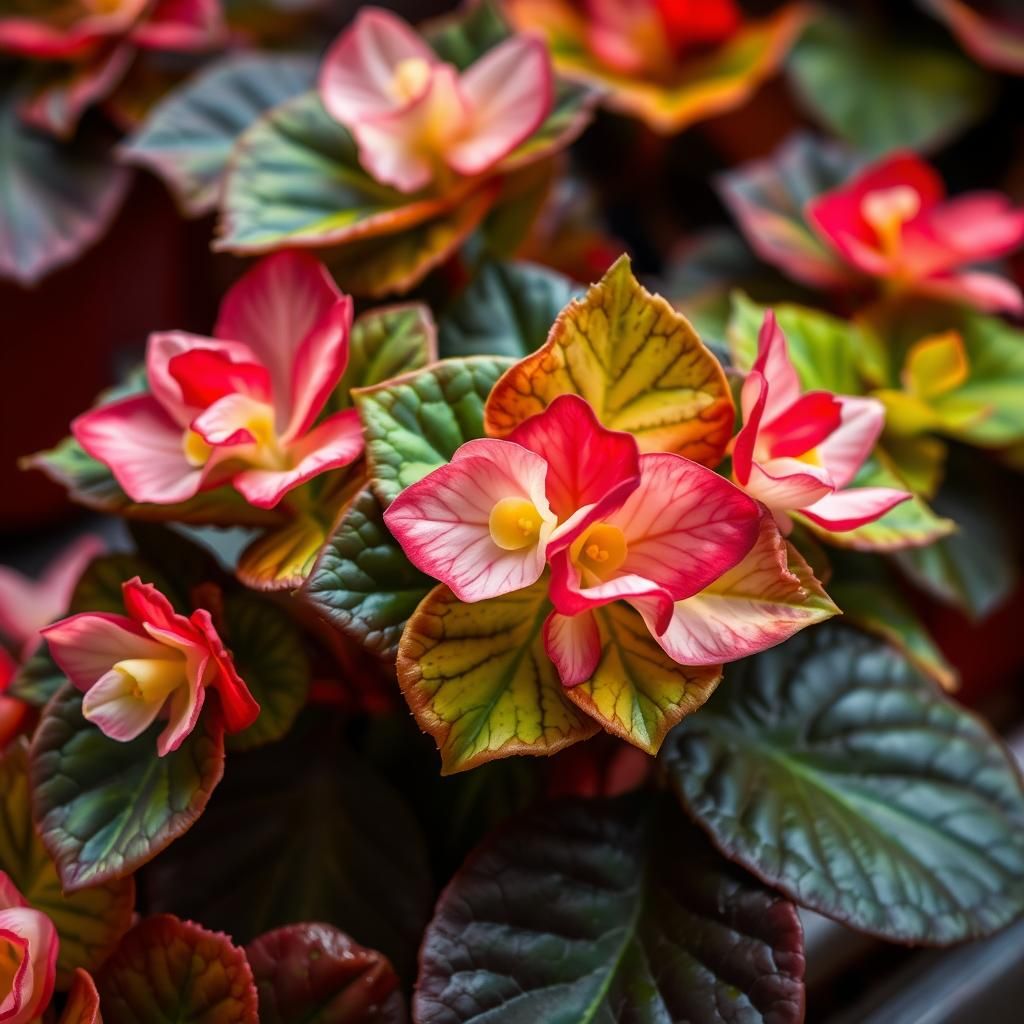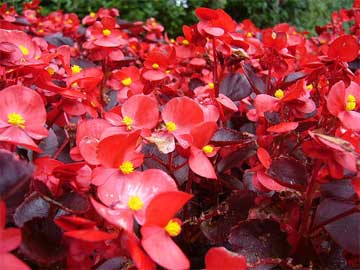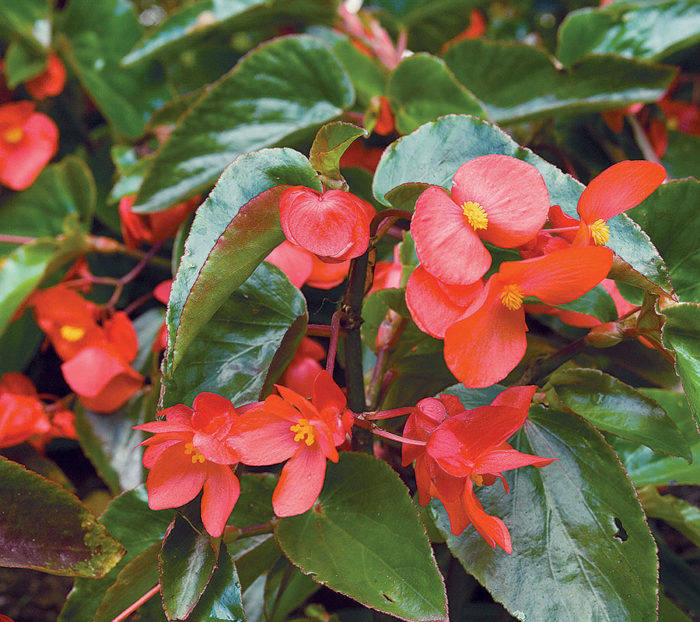Do Begonias Like to Be Crowded? Essential Care Tips for Healthy Growth

When it comes to caring for begonias, understanding their preferences can significantly impact their growth and vitality. One common question among gardeners is whether these beautiful plants thrive when they are crowded together or if they prefer more personal space. In this article, we will explore the ideal growing conditions for begonias, including pot size, spacing, and soil requirements. By delving into essential care tips, you’ll be better equipped to create an environment that fosters healthy growth, ensuring your begonias flourish and showcase their stunning foliage and blooms. Let's uncover the secrets to successful begonia care!
Do Begonias Prefer Crowded Conditions?
Begonias are generally not fond of being crowded together; they thrive best when given adequate space to grow. While certain conditions can lead to them successfully coexisting in close quarters, such as providing sufficient light and proper air circulation, overcrowding can lead to various issues like poor root development, increased susceptibility to diseases, and problems with moisture retention. It's essential to ensure that begonias have the necessary room around them to develop their roots properly and maintain overall health.
Understanding Begonia Growth Requirements
Begonias are adaptable plants, but they have specific growth requirements that must be met for optimal health. They prefer well-draining soil, moderate humidity, and indirect light. Without these conditions, especially in crowded settings, their growth can become stunted, and they might not flourish as expected, ultimately affecting their aesthetic appeal.
The Impact of Crowding on Root Development
When begonias are planted too closely together, their roots may become entangled, leading to competition for nutrients and water. This competition can result in inadequate nutrient absorption, leaving each plant weakened. As a result, a crowded environment can hinder their overall vitality, making them more susceptible to stress and less able to thrive.
How Overcrowding Affects Disease Resistance
In crowded conditions, begonias are more prone to various diseases, particularly fungal infections that thrive in humid environments. With limited airflow around each plant, moisture can linger, creating ideal conditions for pathogens to flourish. Maintaining adequate spacing helps reduce these risks, promoting healthier plants that are more resistant to disease.
Optimal Spacing for Healthy Begonias
To ensure begonias thrive, it is advisable to space them adequately apart. A general guideline is to plant them about 6 to 12 inches apart, depending on the specific variety. This spacing allows for proper airflow, sunlight penetration, and optimal root growth, contributing to lush and vibrant foliage and blooms.
Signs of Overcrowding in Begonias
When begonias are overcrowded, certain symptoms may become apparent. These can include yellowing leaves, stunted growth, and increased leaf drop. If you notice these signs, it may be time to repot or divide your begonias to provide them the space they need to regain their health and vigor.
| Issue | Effect |
|---|---|
| Crowding | Competes for nutrients and water |
| Poor Airflow | Increases disease susceptibility |
| Entangled Roots | Hinders root growth |
| Insufficient Light | Stunted growth |
| Humidity | Promotes fungal infections |
How close together can I plant begonias?

To determine how close together you can plant begonias, it's essential to consider the specific type of begonia you are planting, as well as the growing conditions and desired aesthetic. Generally, begonias thrive when spaced appropriately to ensure adequate air circulation and light penetration.
For most types of begonias, a spacing of between 12 to 18 inches apart is recommended. This distance allows for healthy growth while preventing overcrowding, which could lead to issues like disease or pest infestations. In containers, begonias can be planted closer together, but it’s important to ensure that each plant has enough room for their root systems to develop.
Factors Influencing Spacing
When deciding how close to plant begonias, consider the following factors:
- Begonia Type: Different begonias have varying growth habits. For example, trailing begonias can be planted closer than upright types.
- Growing Conditions: Consider light availability and air circulation in your planting area, as these affect how closely you can plant your begonias.
- Container vs. Garden: In garden beds, allow for more space than in containers to prevent competition for nutrients.
Common Begonia Types and Spacing Recommendations
Planting distance can vary with different begonia varieties. Here are some guidelines:
- Fibrous-rooted Begonias: Space these 12 to 15 inches apart as they grow bushy and require more room.
- Tuberous Begonias: These should also be spaced 12 to 18 inches apart to allow for their larger blooms.
- Wax Begonias: You can plant these slightly closer, about 10 to 12 inches apart, due to their more compact growth.
Planting in Containers
When planting begonias in containers, the space you provide is crucial. Here’s what to consider:
See also:
- Container Size: Use a larger container to reduce competition, allowing each plant around 10 inches of space.
- Variety Selection: Choose smaller or trailing varieties for containers to maximize space.
- Soil and Care: Ensure that the soil allows for drainage to prevent root rot, especially in smaller pots.
Benefits of Proper Spacing
Correct planting spacing offers several advantages:
- Improved Airflow: Spacing reduces humidity around plants, which helps prevent fungal diseases.
- Better Light Access: Each plant receives ample sunlight for optimal growth and flowering.
- Targeted Nutrients: Reduces competition for resources, allowing for healthier plants.
Signs of Overcrowding
Recognizing signs that your begonias are too close can prevent future issues:
- Wilting Leaves: Overcrowded plants may show signs of stress, like wilting or yellowing leaves.
- Pest Issues: Increased humidity and limited airflow can lead to higher pest problems.
- Stunted Growth: Plants may not reach their full potential in overcrowded conditions.
Do begonias like being crowded?

Begonias, a popular choice for houseplants and garden flowers, have specific needs regarding space and growing conditions. These plants generally do not thrive when they are overly crowded. Here’s a detailed exploration of why begonias prefer room to grow, enhanced with related subtopics.
Understanding Begonia Growth Habits
Begonias are known for their beautiful foliage and flowers, but their growth habits significantly impact how they should be cared for. When begonias are overcrowded, they compete for vital resources such as light, water, and nutrients. This competition can lead to stunted growth and poor health outcomes. Key points include:
- Begonias require sufficient light to thrive.
- Overcrowding can lead to reduced air circulation around the plants.
- When plants are close together, they may not receive adequate nutrients from the soil.
Impact of Crowding on Begonia Health
Crowding can have a detrimental impact on the overall health of begonias. Stress factors induced by overcrowding can lead to various issues, including pests and diseases. It is crucial to monitor their condition; overcrowded begonias may exhibit:
- Wilting leaves due to insufficient water absorption.
- Increased susceptibility to fungal infections and pests.
- Leaf drop or yellowing foliage as a sign of stress.
Optimal Spacing for Begonias
To promote healthy growth and vibrant blooms, it is essential to provide optimal spacing between begonias. The ideal distance allows each plant to access resources without hindrance. Recommended spacing includes:
- For smaller begonia varieties, a spacing of 6 to 12 inches apart.
- For larger varieties, consider spacing them 12 to 18 inches apart.
- Adjust spacing based on growth habits and specific species requirements.
Signs Your Begonias Are Overcrowded
It is essential to recognize the signs that may indicate overcrowding in your begonia plants. Identifying these signs can prevent long-term damage to the plants. Common symptoms include:
- Stretching towards light indicating insufficient exposure.
- Browning or crispy leaf edges due to inadequate air flow.
- Rootbound conditions where roots circle the pot excessively.
Tips for Preventing Overcrowding
Preventing overcrowding is vital for the successful cultivation of begonias. Here are some effective tips to ensure that your plants remain healthy and well spaced:
- Regularly prune your begonias to promote airflow and space.
- Repot them into larger containers when growth becomes constrained.
- Consider using dividers or planting in groups to maintain distance.
What is the secret to growing begonias?
:max_bytes(150000):strip_icc()/begonias-care-guide-7108561_01-cae8e12094fd45bca1a8256692dab20f.jpg)
To successfully grow begonias, it is essential to understand their particular needs regarding light, water, soil, and humidity. The secret lies in creating an optimal environment that mimics their natural habitat while ensuring they receive proper care.
Choosing the Right Variety
Different types of begonias exhibit unique characteristics and care requirements. Selecting the right variety for your specific growing conditions is crucial:
- Fibrous-rooted begonias: These are ideal for outdoor gardens and require well-drained soil.
- Tuberous begonias: Best for adding color and flourish in shady areas, but they need additional care during winter months.
- Rhizomatous begonias: Known for their striking foliage and can thrive indoors with proper humidity and light.
Light and Location
The placement of begonias significantly impacts their growth. Understanding their light needs is key:
See also:
- Indirect sunlight: Begonias thrive in bright, indirect light. Too much direct sunlight can scorch the leaves.
- Shade requirements: Some varieties prefer partial to full shade, especially in hotter climates.
- Indoor light conditions: Provide them with bright, filtered light near windows, away from drafts and direct heat sources.
Watering Techniques
Correct watering practices are vital for the health of begonias. Overwatering or underwatering can lead to issues:
- Moisture levels: Keep the soil consistently moist but not soggy. Check the top inch of soil before watering.
- Watering frequency: Depending on the season, water more frequently in warmer months and lessen during winter.
- Drainage: Ensure pots have drainage holes to prevent root rot, which is a common ailment in begonias.
Soil Requirements
The right soil composition is essential for healthy begonia growth. Here are the primary factors:
- Well-draining soil: Use a blend of potting soil, perlite, and a small amount of peat to ensure proper drainage.
- pH levels: Aim for soil pH between 6.0 and 7.0 for optimal nutrient absorption.
- Fertilization: Feed with a balanced, water-soluble fertilizer every four to six weeks during the growing season.
Humidity and Temperature
Begonias require specific humidity and temperature levels to flourish:
- Humidity levels: Maintain a humidity level of around 50-70% for optimal growth, especially for indoor begonias.
- Temperature range: Keep temperatures between 60°F to 75°F (15°C to 24°C). Avoid exposure to cold drafts.
- Humidity aids: Consider using a humidity tray filled with water to promote a damp environment if your home is dry.
What makes begonias happy?

Begonias are a diverse group of plants that thrive under specific conditions, making them relatively easy to care for when their needs are met. To keep your begonias happy and healthy, several factors should be considered, including light, water, soil, temperature, and humidity.
Light Requirements
Begonias generally prefer indirect sunlight. Too much direct sun can scorch their leaves, while too little light can hinder their growth. Here’s what you should keep in mind:
- Place begonias in bright, filtered light.
- Avoid placing them in areas with direct afternoon sun.
- Consider rotating the plant occasionally to ensure even light distribution.
Watering Practices
Proper watering is crucial for the health of begonias. Overwatering can lead to root rot, while underwatering can cause wilting. Here are some tips for effective watering:
- Water the soil thoroughly until it drains from the bottom of the pot.
- Allow the top layer of soil to dry out before watering again.
- Use room temperature water to avoid shocking the plant.
Soil Composition
Begonias thrive in a well-draining soil mixture that retains some moisture but also allows excess water to escape. To create the ideal soil environment:
- Use a potting mix that includes peat moss or coconut coir.
- Add perlite or vermiculite to improve drainage.
- Avoid heavy garden soils that can compact around the roots.
Temperature Preferences
Temperature significantly impacts the growth of begonias. They tend to prefer a warm environment. Here are some temperature considerations:
- Maintain temperatures between 60°F and 75°F (15°C to 24°C).
- Avoid placing begonias near cold drafts or heating vents.
- Monitor evening temperatures, as they should not drop below 50°F (10°C).
Humidity Levels
Begonias enjoy high humidity, which can mimic their natural tropical environment. To ensure adequate humidity for your begonias:
- Consider using a humidifier in the room.
- Group begonias with other plants to create a more humid microclimate.
- Place a tray of water with pebbles under the pot to increase humidity without waterlogging the roots.
Questions from Our Readers
Do begonias like to be crowded?
Begonias generally do not like to be crowded. They thrive best when they have sufficient space to grow, which allows for better air circulation and access to nutrients. When begonias are too close together, they may experience stunted growth, increased pest problems, and disease issues.
What happens if begonias are overcrowded?
If begonias are overcrowded, they can suffer from a variety of issues, including poor growth and an increased likelihood of fungal infections. The lack of sunlight and airflow can create a favorable environment for pests, negatively impacting the plant's overall health.
How much space do begonias need between plants?
It is recommended to give begonias about 12 to 18 inches of space between each plant. This distance allows for proper growth, enhancing their ability to absorb nutrients and receive adequate light. Sufficient spacing also helps reduce the risk of disease transmission among plants.
See also:
Can I plant begonias close together for aesthetic purposes?
While it might be tempting to plant begonias close together for aesthetic reasons, it is not advisable for their long-term health. To maintain their vibrancy and resilience, giving them the necessary space is crucial, as this will ultimately lead to healthier and more robust plants.

If you want to read more articles like Do Begonias Like to Be Crowded? Essential Care Tips for Healthy Growth, we recommend you check out our Plants category.
Leave a Reply
Related Articles